10.3. Games Windows Vista comes with plenty of built-in games, but if you're using Windows Vista Business, you may wonder why everyone else gets all the funthere don't seem to be any games for you to play. Worry not; you won't be left out of the fun. You can turn on access to the games by going to Control Panel  Programs Programs  Turn Windows features on or off, and selecting Games. Just dont let your boss know you did it. Turn Windows features on or off, and selecting Games. Just dont let your boss know you did it. Chess Titans: \Program Files\Microsoft Games\chess\chess.exe Play chess against your computer. To open Start  All Programs All Programs  Games Games  Chess Titans Chess Titans Description Chess Titans (Figure 10-27) lets you play chess against your computer or against a human opponent, although you don't play a human onlineinstead, you each take turns at the keyboard. When you play against the computer, you can choose from beginner, intermediate, and advanced levels. Figure 10-27. Chess Titans 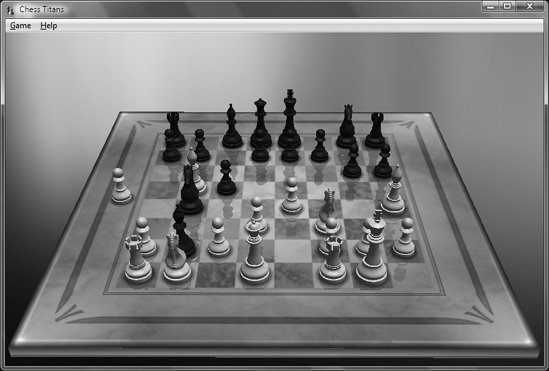
Choose Game  Options to change whether you play as white or black, to change the level of difficulty, to change the graphics quality, and to choose many other options, such as whether to play animations and sounds, and what view to use. Options to change whether you play as white or black, to change the level of difficulty, to change the graphics quality, and to choose many other options, such as whether to play animations and sounds, and what view to use. To change the view of the game, hold down the right button and drag with your mouse. To choose a different-looking chess set or to change the board background, choose Game  Change Appearance or press F7. Change Appearance or press F7. Notes |
FreeCell: \Program Files\Microsoft Games\FreeCell\FreeCell.exe A solitaire card game, considered by many users to be more addictive than traditional Solitaire (Klondike). To open Start  All Programs All Programs  Games Games  FreeCell FreeCell Description FreeCell is a solitaire card game (see Figure 10-28), but you play it differently than the traditional Klondike game (see "Solitaire," later in this chapter). The object of the game is to move all the cards to the home cells. Figure 10-28. FreeCell 
As with Klondike, you arrange your cards by placing them in descending value and alternating color (you can place the Four of Clubs on the Five of Hearts or the Five of Diamonds). Click a card to highlight it and click another card to move the highlighted card. You can move multiple cards, but only those that are arranged accordingly. You also can move cards to one of the four "free cells," temporary storage slots that fill up fast. FreeCell is somewhat like a cross between Klondike and the Towers of Hanoi puzzle. Notes In FreeCell, cards are not dealt randomly. Rather, there are 32,000 distinct, numbered games, each representing a different predetermined deal of the cards. According to the help, "It is believed (although not proven) that every game is winnable." In fact, it has been proven that game #11,982 is indeed not winnable. Don't believe me? Press F3 and then select 11982.
See also "Solitaire" and "Spider Solitaire" |
Games Explorer A specialized Windows Explorer folder that serves as the central location for all your games. To open Start  All Programs All Programs  Games Games  Games Explorer Games Explorer Description Games Explorer (see Figure 10-29) is a specialized Windows Explorer folder that lists all of your games and gives you a variety of other features and tools related to them. It shows a list of every game; click on one and in the preview pane you'll see various ratings related to it. Games Explorer will list the performance ratings recommended and required for that game, and your current system's performance ratings, so that you'll know whether your hardware can properly handle it. (For details about performance ratings, see "Performance Information and Tools," in Chapter 11.) It also lists the Entertainment Software Rating Board (ESRB) suitability rating for the game. Figure 10-29. Games Explorer, the central location for all your games 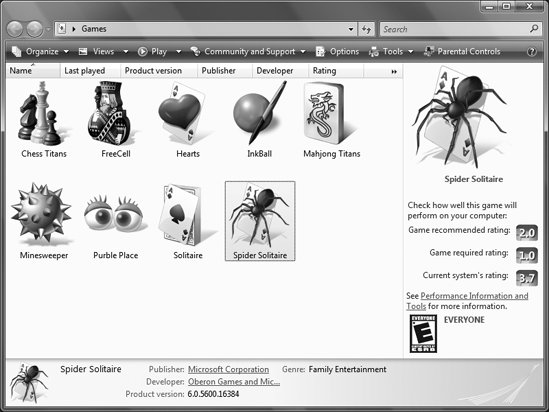
Click the Play button and you'll get a list of all of your saved games for every game. The Community and Support button leads you to relevant (and not-so-relevant) web sites. The Options button lets you control whether to download information about your installed games and whether to list your most recently played games, and will clear out the list of your most recently closed games, if you so choose. Notes New games generally will show up in Games Explorer automatically, but some older ones might not. If a game doesn't appear, open Games Explorer and drag the game's executable file into the folder. Games Explorer might not recognize the game; if that's the case, it will ask you for information about it. For extra features, display the menu bar in the folder by choosing Organize  Layout Layout  Menu Bar. Among the extra features you can access is the ability to hide a game from view. You can also hide a game without relying on the menu bar. Right-click a game and choose Hide. Menu Bar. Among the extra features you can access is the ability to hide a game from view. You can also hide a game without relying on the menu bar. Right-click a game and choose Hide.
See also "Performance Information and Tools," in Chapter 11 |
Hearts: \Program Files\Microsoft Games\Hearts\Hearts.exe A card game played with three opponents. To open Start  All Programs All Programs  Games Games  Hearts Hearts Description Hearts is a trick-based game, like Spades, but the object is to have the lowest score at the end of each hand. The online help tells you how to play the game and provides strategy and tips (see Figure 10-30). Figure 10-30. Hearts, which lets you play the classic card game against artificial opponents or other people on your network 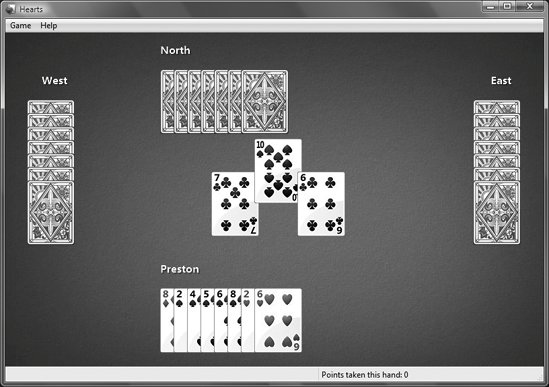
Notes Normally, the object of Hearts is to stick your opponents with as many points (hearts) as possible. However, if one player takes all the points in a hand, it's called "shooting the moon": that player gets 0 points and everyone else gets 26 points.
|
InkBall: \Program Files\Microsoft Games\inkball\InkBall.exe Guide the colored balls into holes of the same color. To open Start  All Programs All Programs  Games Games  InkBall InkBall Description This simple game (Figure 10-31) is best suited for Tablet PCs, although it also works fine on regular PCs. You guide colored balls into holes of the same color by drawing barriers with the mouse or tablet. Similarly, you need to keep balls from going into a hole of a different color. When you draw a line, the ball bounces off it; as soon as the ball bounces away, the line disappears. You can draw multiple lines as well. You lose when a ball falls into a hole of a different color or the timer runs out. Figure 10-31. InkBall, a simple game in which you guide colored balls into holes of the same color by drawing barriers with the mouse or tablet 
There are five levels of difficulty; at upper levels there are barriers, multiple balls of multiple colors that spin at odd angles, and other conundrums. Notes Gray balls are allowed to enter any colored hole, and gray holes accept a ball of any color. No points are awarded when a gray ball enters a hole, and the game does not end when a colored ball enters a gray hole. An ink stroke can affect only one ball.
|
Mahjong Titans: \Program Files\Microsoft Games\Mahjong\Mahjong.exe Clear all the tiles by eliminating matching ones. To open Start  All Programs All Programs  Games Games  Mahjong Titans Mahjong Titans Description Mahjong, as played on the computer, isn't the same thing as the classic Chinese game, as I can attest from personal experience because my decidedly non-Asian mother played countless rounds of the game against her friends throughout my youth. On the PC, there is no betting or clicking of tiles. Instead, Mahjong Titans (Figure 10-32) is a much simpler game. You click on matching tiles to remove them, and if you clear all the tiles you win. You play against the clock. Figure 10-32. Mahjong, a game in which you clear all the tiles to achieve victory 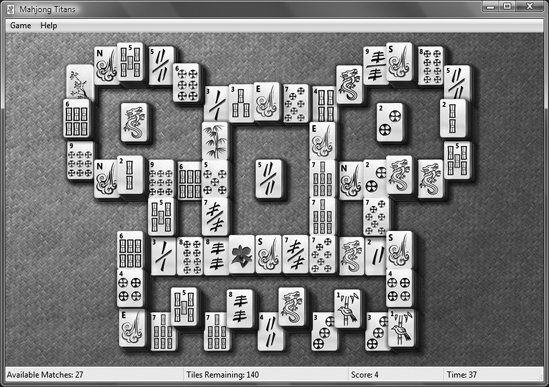
You choose from multiple boards with varying levels of difficulty, and you can also choose different tile backgrounds, specify whether to use animation, and so on, by selecting Game  Options. Options. |
Minesweeper: \Program Files\Microsoft Games\Minesweeper\Minesweeper.exe A quick game relying on the process of elimination. To open Start  All Programs All Programs  Games Games  Minesweeper Minesweeper Description The object of Minesweeper is to uncover "safe" areas on a playing field without hitting any landmines. Start by clicking a square with the left mouse button to uncover it; if it's a mine, the game is over. Otherwise, you'll either see a number corresponding to the number of mines immediately adjacent to the clicked square, or the square will be blank, meaning that there are no adjacent mines. If you click a square with no adjacent mines, all the connecting squares are automatically uncovered until a numbered square is reached. Use the numbers as hints to where the mines are located; use the process of elimination to uncover all the squares that aren't mines. Use the right mouse button to mark and unmark uncertain squares, which has the added benefit of preventing them from being clicked accidentally (see Figure 10-33). Figure 10-33. Minesweeper, a game in which you try to clear the minefield 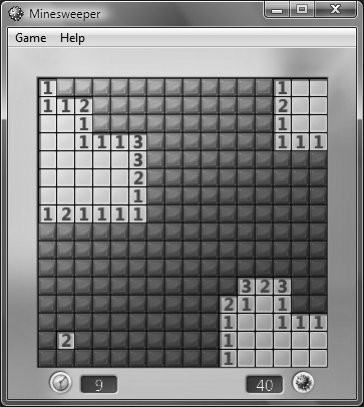
Notes The beginner game uses a 9x9 grid with 10 mines; intermediate uses a 16x16 grid with 40 mines; and advanced uses a 30x16 grid with 99 mines. You can also create custom games, such as an easy 30x30 grid with only 10 mines or a difficult 8x8 grid with 60 mines. If a number appears on a square, it specifies how many mines are in the eight squares that surround it.
|
Purble Place: \Program Files\Microsoft Games\Purble Place\PurblePlace.exe Three simple games for children. To open Start  All Programs All Programs  Games Games  Purble Place Purble Place Description These three simple games for very young children focus on matching and memory skills. One is a concentration-type game in which children click on tiles to reveal pictures beneath and match tiles to remove them from the board. In another (Figure 10-34), children have to match shapes and colors to those on a cake in order to make a cake and ship it. In the third, children design a simple face. Figure 10-34. One of three simple children's games that make up Purble Place 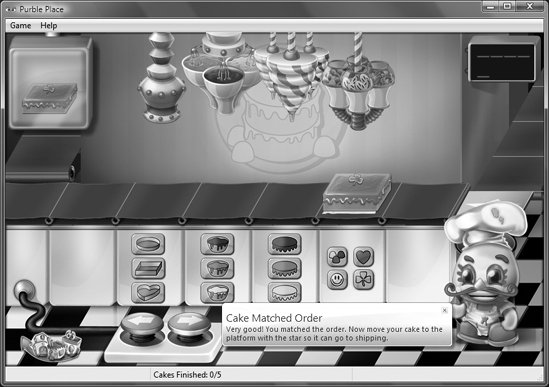
|
Solitaire: \Program Files\Microsoft Games\Solitaire\Solitaire.exe The traditional Klondike solitaire card game. To open Start  All Programs All Programs  Games Games  Solitaire Solitaire Description Solitaire, the simple card game included with every version of Windows since Windows 3.0, is a single-player game that follows the traditional Klondike rules (see Figure 10-35). The object of the game is to organize all the cards by suit and place them in order (starting with the Ace) in the four stacks at the top of the window. You move cards by placing them on the seven piles in sequential descending order, alternating color. For example, place a black four on a red five, or a red Jack on a black Queen. The game is over when all the cards have been moved to the top stacks. Figure 10-35. The original Solitaire (Klondike) game, a great way to waste time at work 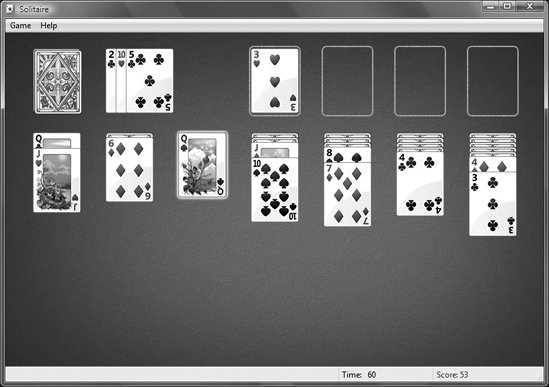
You can choose a new look for the deck by going to Game  Change Appearance or pressing F7. Go to Game Change Appearance or pressing F7. Go to Game  Options to choose whether one or three cards are drawn from the deck at a time, which type of scoring to use, whether the game is timed, whether to display animations, and more. Options to choose whether one or three cards are drawn from the deck at a time, which type of scoring to use, whether the game is timed, whether to display animations, and more.
Notes Solitaire is a teaching tool for those just learning to use a mouse. It's a great way to learn clicking, double-clicking, and dragging, and best of all, the student often becomes addicted to the lesson! When Windows 3.0 was first released in the late 1980s, the most flattering thing that some critics had to say about Microsoft's latest and greatest operating system was that it was a "great solitaire game."
See also "FreeCell" and "Spider Solitaire" |
Spider Solitaire: \Program Files\Microsoft Games\SpiderSolitaire\SpiderSolitaire.exe A variation on the Solitaire card game, using eight piles. To open Start  All Programs All Programs  Games Games  Spider Solitaire Spider Solitaire Description Spider Solitaire (see Figure 10-36) is a simple card game, similar to Solitaire (discussed in the preceding section). The object is to arrange the cards sequentially and by suit. You move cards by placing them on the eight piles in descending order, following suit. For example, place the Jack of Spades on the Queen of Spades, or the Two of Hearts on the Three of Hearts. When you complete an entire suit, King to Ace, it is removed from the board. The game ends when all cards have been removed. Figure 10-36. Spider Solitaire, not nearly as addictive as Klondike or FreeCell, but if you like arachnids . . . 
The game is always played with 52 cards, but easier skill levels (chosen at the beginning of the game) reduce the number of suits; for example, the easiest skill level uses all spades. Go to Game  Options to choose your preferences, such as whether your game is saved when you exit. Options to choose your preferences, such as whether your game is saved when you exit. See also "Solitaire" and "FreeCell" |
|
 Programs
Programs  Turn Windows features on or off, and selecting Games. Just dont let your boss know you did it.
Turn Windows features on or off, and selecting Games. Just dont let your boss know you did it.









